



© David Hallam 1988 - 2006
|
Black & Gold - the Story of 2nd Beeston Sea Scouts - continued
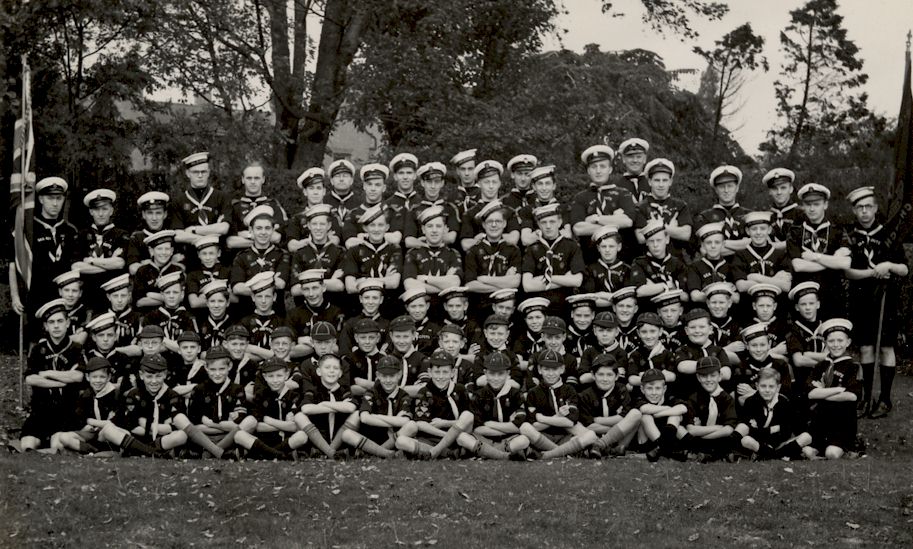 Sailing With the Wind (January 1950 to October 1958) -
The 1950s opened with a period of unprecedented success for the Group. (The photograph on the left shows the Group in 1950. Click the image for
a full-size view and others taken on the same occasion) Starting with 37 members in 1950, the Junior Section quickly grew to 42 in the following year. By then the Troop was only taking recruits
from the Cub Pack. This number put a great strain on resources and some changes were made to try to compensate. At the River Base, the bunkhouse was extended
to take about another six bunks and new heads were built, but this still meant that the base could only accommodate about half the Scouts at any one time. To
provide for this situation, the base was available on alternate weeks to the Port and Starboard Watches of the Troop. On top of that, the Senior Section had
to be accommodated.
Sailing With the Wind (January 1950 to October 1958) -
The 1950s opened with a period of unprecedented success for the Group. (The photograph on the left shows the Group in 1950. Click the image for
a full-size view and others taken on the same occasion) Starting with 37 members in 1950, the Junior Section quickly grew to 42 in the following year. By then the Troop was only taking recruits
from the Cub Pack. This number put a great strain on resources and some changes were made to try to compensate. At the River Base, the bunkhouse was extended
to take about another six bunks and new heads were built, but this still meant that the base could only accommodate about half the Scouts at any one time. To
provide for this situation, the base was available on alternate weeks to the Port and Starboard Watches of the Troop. On top of that, the Senior Section had
to be accommodated.
During the winter months the weekly meetings for the Junior Section were held each Friday evening at the Station Road Headquarters. In the summer months
these meetings were held at the River Base. For a time, an additional Saturday afternoon meeting was held at Station Road to make inroads into badge work.
The tradition of regular Church Parades - on the first Sunday in each month - continued all through this period. At the weekend 'camps', at the River
Base, working parties were still necessary to maintain and improve the facilities but there was still enough time for water activities and badge work.
The Groupís two cob boats were the backbone of the boat fleet at that time and they formed the basis of the river training - mostly rowing and sculling
although there was an outboard motor which had been purchased with funds made available by the Rover Crew. In addition there was a sailing dinghy - although
little sailing was done - and a few privately owned kayaks. Typical activities at the
bases can be seen here
A well developed system for catering was in operation for the weekend sessions the result, no doubt, of the continuing need, at least for part of this
period, for Food Ration Books for some foods. Each of the lads brought with them any item which could reasonably be considered an individual item, personal
to themselves or which was 'on the ration'. Examples would include a tin of beans or a can of soup each of which would be cooked in the tin and eaten
directly rather than shared. The most expensive item in that list was the jar of jam each was expected to bring. For everything that was part of the
general catering requirements - bread, tea, salt, etc - each paid an amount - believed to be 2 shillings (10p). This money was spent during a weekly
visit to Doarís Grocery then in Beeston Square. It was probable that this shop was used because its Manager was Ben Wilson, that Scouter with such a
long association with SW Notts. Drinking water was then, as now, brought up from Mitchells' Boathouse although at that time ex-army jerry cans were
used.
The Annual Camp in 1950 was at Llanfairfechan in North Wales with nearly 40 members attending.
(Click the link for more details and photographs)
This camp was in a field by the side of the Railway with the Penmaen Mountain slightly inland. On the Monday, several
rovers climbed to its top and semaphored a message to camp and was duly replied to, by Breeze Smedley, in Morse. This prompted a large party of juniors and officers
to make the climb. On Wednesday, what had become the traditional rover fishing party hired a motor boat in search of mackerel. After getting soaked waiting for the
boatman, the actual trip took place in perfect fishing weather resulting in an excellent catch. The catch of over 100 fish was brought back to the camp in Breeze's
Jowett car and, after a grand gutting session, all hands enjoyed a mackerel supper. After a postponement on Thursday because of rain, 31 members of the camp took a bus
tour through the Nant Francon Pass on the Friday. They returned at 6 pm for tea followed by the traditional patrols' 'bean-feast'. A camp-fire closed
the successful camp for another year. The camp song that year was 'Roll a Silver Dollar'.
New names appearing that year included John Asher, Peter Cross, John Guest, David Hallam, Frazer Heselton, Ted Morris, Michael Pokorny, David Rose,
Nicky Stephens, Michael Stewart, Chris Tizzard and Michael Wright. David Highton and Alan Bailey attended the 1950 camp as cubs and became scouts during
the following year.
In August 1950, the Group also attended the International Jamboree at Walesby.
(Click for a scene from that highly successful international event.)
 Bob-a-Job Week had started in 1948 and in the early 1950s had still not lost its novelty and was an important source of income. In 1951, for instance,
the Juniors raised about £38 which, at almost a Pound a head, exceeded their subscriptions. Bob-a-Job takings for the Group as a whole that year totaled
£52 with about £11 being due for the District Levy. It was in that year David Hallam and Michael Pokorny set up a shoe-shine stand in Beeston Square
as part of Job Week. (They are seen left, with Councillor Peel, Chairman of Beeston & Stapleford Urban District Council getting an early shine)
In 1953, a prize - a Coronation Crown coin - was offered to the scout with the highest job earnings - it was won by Nicky Stephens
with a total of £3. By the mid 1950s, takings were substantially down as the novelty of the scheme faded.
Bob-a-Job Week had started in 1948 and in the early 1950s had still not lost its novelty and was an important source of income. In 1951, for instance,
the Juniors raised about £38 which, at almost a Pound a head, exceeded their subscriptions. Bob-a-Job takings for the Group as a whole that year totaled
£52 with about £11 being due for the District Levy. It was in that year David Hallam and Michael Pokorny set up a shoe-shine stand in Beeston Square
as part of Job Week. (They are seen left, with Councillor Peel, Chairman of Beeston & Stapleford Urban District Council getting an early shine)
In 1953, a prize - a Coronation Crown coin - was offered to the scout with the highest job earnings - it was won by Nicky Stephens
with a total of £3. By the mid 1950s, takings were substantially down as the novelty of the scheme faded.
The Annual Camp in 1951 was held at Rowen, near Conway, North Wales. This camp coincided with the high point of membership numbers and, at 60 members, it
had the highest attendance yet. This was a most excellent site and it is well remembered by all who attended. A quest at the camp was District Commissioner
Henry Middleton who organised one of the memorable camp-fires he is famous for. On a starlit night, the waiting participants saw an approaching line of
torch-bearers - the Seniors - who ceremonially lit the waiting camp-fire.
New members about that time included David Highton, Paul Middleton (who came to the Rowen camp whilst still a member of 6th Beeston), Trevor Jones, Pilgrim,
Michael Smith, Michael Stewart, Geof Turton, Eric Warren and Woodcock.
Don Hallam, the Scoutmaster, and R. Hewitt had been chosen for inclusion in the Nottinghamshire contingent to the International Jamboree in Austria that
year. For that reason, they missed the camp at Rowen. However, the diet at future River Base weekend camps benefited considerably from the large quantity
of pate de fois gras which was brought back !
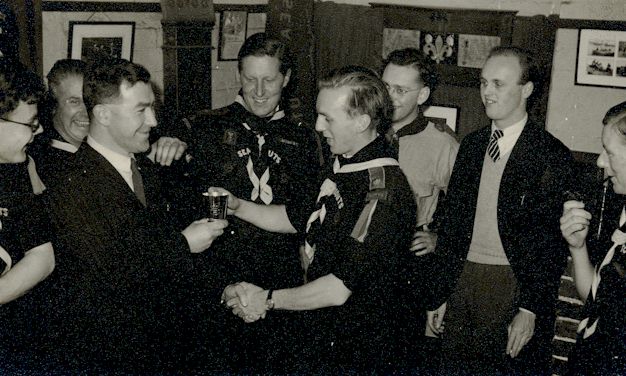 The cubs, at that time, usually had their full numbers and often had a waiting list. Harry Bailey continued to lead them until he was transferred to Liverpool
in early 1952; on his leaving, he was presented with a tankard by the Rover Crew. (Click the image for more detail) Up to 1955, the pack was in the
charge of a number of leaders including Colin Thornhill - until he entered the Forces - and Noel Ball with Disney Keeble filling in the gaps. Harry Beastall. who
had assisted with the cubs since 1950, replaced Brian Underwood as ASM in 1951. In 1955, the Pack Leaders were Mrs Jones and Mr Prescott with Miss Stone taking over
in 1957. A steady stream of badges were gained and the Pack provided excellent material to the Scout Section. The Pack won the District Totem Pole in 1950 and did
well in a succession of Swimming Galas.
The cubs, at that time, usually had their full numbers and often had a waiting list. Harry Bailey continued to lead them until he was transferred to Liverpool
in early 1952; on his leaving, he was presented with a tankard by the Rover Crew. (Click the image for more detail) Up to 1955, the pack was in the
charge of a number of leaders including Colin Thornhill - until he entered the Forces - and Noel Ball with Disney Keeble filling in the gaps. Harry Beastall. who
had assisted with the cubs since 1950, replaced Brian Underwood as ASM in 1951. In 1955, the Pack Leaders were Mrs Jones and Mr Prescott with Miss Stone taking over
in 1957. A steady stream of badges were gained and the Pack provided excellent material to the Scout Section. The Pack won the District Totem Pole in 1950 and did
well in a succession of Swimming Galas.
In 1952 the Summer Camp was back at Rowen and that year the site was used in
successive weeks by three Beeston scout troops who shared the equipment and the cost of getting it there. In those days, camp equipment was sent ahead
by rail and British Rail would supply a luggage van for the purpose which they would park in a siding at Beeston Station while the members loaded it
during the previous week. That year, a time had been quoted for one evening when the train would pick up the van and a working party was formed
accordingly to move the equipment down Station Road by trek cart with the other troops doing the same. Half way through the evening it was found that
the van would leave an hour earlier and it suddenly seemed an impossible task to get the job complete. Perhaps spurred on by the other Troops, the
impossible task was taken on. All hands were mobilised to move the gear down by all available means - impossibly heavy, bulky loads were transported by
cyclists, on foot and by the trek cart at a hectic pace. The SM cycled down with two wooden seating benches, about 8 feet long, balanced on one
shoulder - an example of the seemingly impossible loads which were carried by push-bike in those days ! Everything made it with seconds to spare - things
were still being loaded as the van was being coupled ! This camp was for the Junior Section only and was the first of a series of occasions when the
various sections went to separate camps. Apart from two initial days of pouring rain followed by excellent weather, it will be remembered particularly for the
night the whole party spent on top of the mountain, under the shooting stars, on a perfect night with just a tarpaulin underneath and on top to keep
everyone dry. Harry Banner, who had emigrated to New Zealand in 1950, returned that year and appeared at the camp in his New Zealand scout uniform.
That year the Seniors camped on an island off Oban in Scotland and in the next two years went to the Isle of Arran.
By 1952 the Senior Scout section had begun to take off again and had some 16 members. At the AGM that year, their new Scoutmaster, Fred Thraves, expressed
satisfaction with the 'excellent material' which was coming through from the Junior Section. The Seniors met twice a week at that time - on Sunday
mornings for scouting activities and on Thursday evenings for a more widely based general programme. By the following year, six of the section's
members had gained the Queen's Scout Badge and a patrol, under Geoff Stevens, had won both the Inger Trophy and the County Flag by a large margin. To
improve their facilities they constructed a new Senior Den at the Station Road Headquarters and to ease the pressure on accommodation at the River Base
they took the opportunity, in 1953, to take over the use of the Ranger Base, a little downstream from the Scout Base, when the Rangers disbanded. Click
here to see the base when still in use by the Rangers.
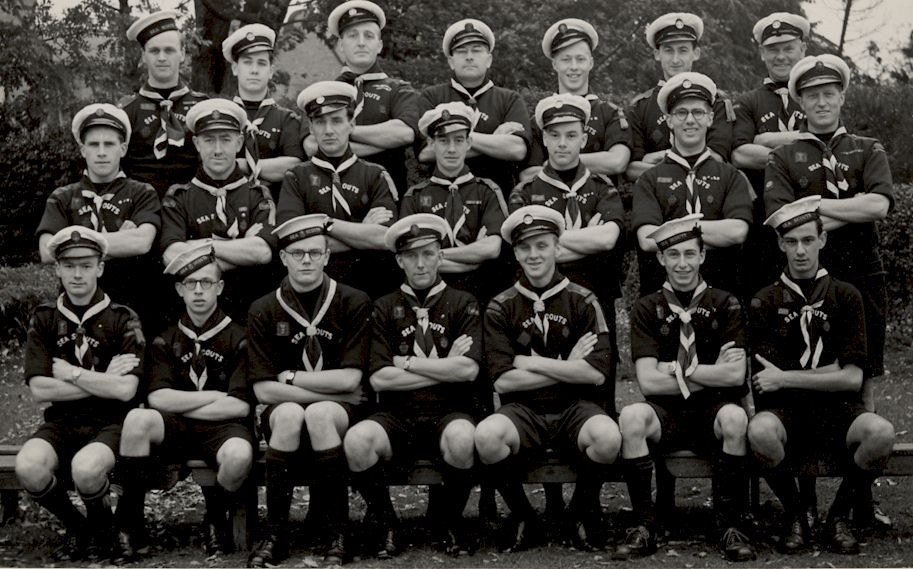 The Rover Crew had mixed fortunes during the 50s. At the beginning they were very strong, having 22 members. (Most of whom are shown in the photograph, taken
about 1950 - click for a full-size view) Nine of this number were Officers but many of were older and, of course, many had family and business responsibilities
which made a coherent programme difficult to maintain. By the time Harry Banner took over from Peter Burton as RSL, it was apparent that there needed to be some
alternative for the older, less active members. In 1952, these members split away to form an Old Scouts Branch but this had only a short life, disbanding and donating
its remaining funds to the Group in 1954 with the wish that they be used to buy boats or other tangible assets.
The Rover Crew had mixed fortunes during the 50s. At the beginning they were very strong, having 22 members. (Most of whom are shown in the photograph, taken
about 1950 - click for a full-size view) Nine of this number were Officers but many of were older and, of course, many had family and business responsibilities
which made a coherent programme difficult to maintain. By the time Harry Banner took over from Peter Burton as RSL, it was apparent that there needed to be some
alternative for the older, less active members. In 1952, these members split away to form an Old Scouts Branch but this had only a short life, disbanding and donating
its remaining funds to the Group in 1954 with the wish that they be used to buy boats or other tangible assets.
All through this period, the Parentsí Committee continued to organise events to raise the money that was urgently needed. For much of this time it was
under the Chairmanship of Mr R S Stephens with Mr Stubbs and later Mr Kirkland as Secretary. Peter Bertram was Treasurer for much of this time with
Bernard Highton also carrying out this job for a while. At one stage, there was over thirty parents on this committee.
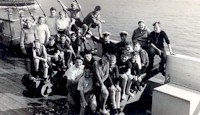 In 1953 and again in 1954, the Juniors went to 'camp' on board the Training Ship Foudroyant in Portsmouth Harbour. These were excellent occasions giving
the lads valuable experience in seamanship skills and a first hand exposure to the Royal Navy in the form of the battleship HMS Vanguard, HMS Dolphin, the
submarine station, and Whale Island, the Gunnery School. Much water based activity was carried out including sailing to the Isle of Wight, taking part in
yacht races, rowing, handling various motor vessels, etc. The Foudroyant was originally HMS Trincomalee but had been captured by the French and renamed
the Foudroyant and then recaptured by the British. It was - and still is - the oldest ship afloat. The boys slept between decks in hammocks strung in the
traditional way. Click the image to see those attending on the 1954 occasion.
In 1953 and again in 1954, the Juniors went to 'camp' on board the Training Ship Foudroyant in Portsmouth Harbour. These were excellent occasions giving
the lads valuable experience in seamanship skills and a first hand exposure to the Royal Navy in the form of the battleship HMS Vanguard, HMS Dolphin, the
submarine station, and Whale Island, the Gunnery School. Much water based activity was carried out including sailing to the Isle of Wight, taking part in
yacht races, rowing, handling various motor vessels, etc. The Foudroyant was originally HMS Trincomalee but had been captured by the French and renamed
the Foudroyant and then recaptured by the British. It was - and still is - the oldest ship afloat. The boys slept between decks in hammocks strung in the
traditional way. Click the image to see those attending on the 1954 occasion.
By this time, or slightly later, the following new names appear - Stephen Aneley, John Bowling, Robert Cox, John Crowther, J. Drinkwater, Geof Golds, Melvin
Golds, M. Hall, R. Hankey, D. Harrison, G. Harvey, Barry Hayes, S. Kingstone, C. Madden, H. Morley, Roydon Orton, Paul Pallant, Robin Soar, John Squirrell,
Roger Sutherland, B. Stoneman, Roger Thornhill, Roger Waldron and Ken Wroughton. Pat Crecraft and Tony Antcliffe transferred from the Henry Mellish
Troop.
In 1954, after two years on the Foudroyant, concern was expressed that the boys had lost touch with camping. An additional camp was therefore held at
Walesby that year. The Rovers held their camp that year on the Island of Kerrera, off Oban.
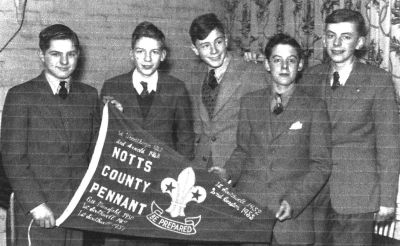 In 1951, Sturdee Patrol, under its Second, Rex Beastall gained the Jardine Trophy and narrowly missed the County Flag that year. However, following the
Seniors' success in the County Flag in 1953, Benbow Patrol under P/L David Hallam was successful in gaining the County Flag for the Junior Section by the
wide margin of nine points. A Group holding both County Flags in one year was something of a record for the day. The image (left) shows Benbow patrol with the
pennant (L-R Chris Tizzard, John Asher, David Hallam, Paul Middleton, Michael Smith)
In 1951, Sturdee Patrol, under its Second, Rex Beastall gained the Jardine Trophy and narrowly missed the County Flag that year. However, following the
Seniors' success in the County Flag in 1953, Benbow Patrol under P/L David Hallam was successful in gaining the County Flag for the Junior Section by the
wide margin of nine points. A Group holding both County Flags in one year was something of a record for the day. The image (left) shows Benbow patrol with the
pennant (L-R Chris Tizzard, John Asher, David Hallam, Paul Middleton, Michael Smith)
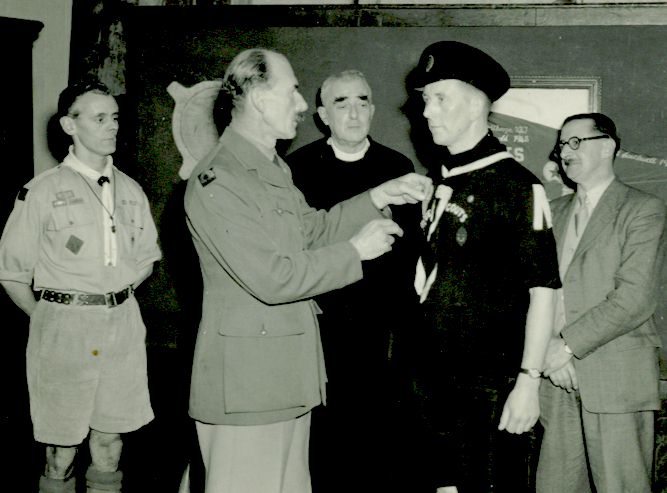 It was particularly appropriate that the Group should have such successes in that year as it was, of course, the year in which the 25th Anniversary was
commemorated. In October a get-together was held for the older members and former members followed, the next evening, by a supper and camp-fire for the
younger members. The following Sunday, a Service of Thanksgiving and Re-Dedication was held in Beeston Parish Church. Afterwards, GSM Bernard Highton was
presented with the Medal of Merit by the County Commissioner, Sir Charles Buchanan. (Click the image for more)
It was particularly appropriate that the Group should have such successes in that year as it was, of course, the year in which the 25th Anniversary was
commemorated. In October a get-together was held for the older members and former members followed, the next evening, by a supper and camp-fire for the
younger members. The following Sunday, a Service of Thanksgiving and Re-Dedication was held in Beeston Parish Church. Afterwards, GSM Bernard Highton was
presented with the Medal of Merit by the County Commissioner, Sir Charles Buchanan. (Click the image for more)
The Group regularly swept the board at the District Swimming Gales at that time, usually taking the Section trophies and most of the individual awards.
At County level they were also very successful at swimming and won the Coulby Cup in 1952. Regular swimming sessions were held each Monday night during
the winter at swimming baths in Nottingham and later a group of Seniors gained Royal Life Saving Society awards.
Another activity undertaken for a while was small bore rifle shooting. This took place on the Boots range at Beeston. In 1953, their first year, they
entered the Connaught Trophy competition and came a reasonably respectable 15th.
1954 was one of the 'water shed' years in the history of the Group. Early in that year, Fred Thraves emigrated to Canada to be joined in the following
October by Don Hallam. During the same few months, the Cubmaster resigned due to ill health. This meant that new leadership was required for three of the
four sections. The new arrangements for the Cubs has already been described, the Junior section continued for a time under the ASM John Fox and when he
too left to go into the Forces, his place was taken by Pat Crecraft. Harry Beastall took over responsibility for the Senior Section, assisted by Nelson
Bateman. Also assisting at this time was Edward Smedley and Mr Warburton, a long time friend of the Group. The natural progression through the Sections
also caused problems - John Fox reported, on taking over, that he had recently lost 15 lads who had progressed to the Seniors 'taking all the badges with
them'.
 Fred Thraves was later to set up a Sea Scout Troop in Sackville,
New Brunswick where he had settled. (Shown right with Fred on the right of the photograph at the back) It was complete with black and gold neckerchiefs and a
meeting room with a 'bridge' resembling the one at Station Road ! Fred Thraves was later to set up a Sea Scout Troop in Sackville,
New Brunswick where he had settled. (Shown right with Fred on the right of the photograph at the back) It was complete with black and gold neckerchiefs and a
meeting room with a 'bridge' resembling the one at Station Road !
In 1955, the Group once more held a combined camp for all sections. This was held at an excellent site at
Pevensey, near Eastbourne, next to Pevensey Castle. 35 members attended in glorious weather and the traditional fishing trip caught a massive catch for the benefit of the supper that
evening. One member, John Guest, made the journey by bike. Tom Prescott joined the Group at about this time as ASM.
That year, and the following year, the Group demonstrated Sea Scouting at the Royal Show in Wollaton Park. Other activities included tha annual
St George's Day Parade and Sea Scout Trophy Competition.
The camp in 1956 was held at the Scout Camp at Windermere. This was a very wet week but some of the Senior
members did manage to get in some excellent sailing on Lake Windermere. By this time, the Junior Section was under the command of George Smedley who was later to become GSM.
The final two years of our story saw two successful Annual Camps. In 1957, the Troop visited Yorks Wood, Castle Bromwich with an outing to the World
Jamboree. The Junior Section also took a party to T.S. Foudroyant that year whilst the Rovers visited Falmouth. In 1958, the Camp was at Hendre Farm,
Conway.
The end of our thirty year story finds the Group still in a strong position and a credit to its officers and friends, past and present. Large numbers of
members, as we have seen, had passed through the ranks, had benefited, and could say with pride, "I was a 2nd Beeston Sea Scout". It was yet to have to
face tremendous changes in the next thirty years - including finding a new Headquarters and a
new River Base - but that is another story which hopefully will one day be told.
|
At the time of writing the original in 1988, the author acknowledged the assistance of Arthur, Edward and George Smedley, Bernard Highton, Disney Keeble, Donald Hallam
and Rex and Melinda Beastall. Photographs have since been added from the collections of Edward Smedley, Disney Keeble, Barrie Fines, Peter Bertram and the author. Further
photograph copies or suggestions for identities of individuals shown are welcome. Dennis Hudston and Peter Bertram have assisted with the identification of individuals
on the various photographs from their respective eras.
There may well be other relevant information and there must be other surviving memories which could be used to enlarge on the story and, indeed, correct the inevitable
inaccuracies which this account will contain. The author considers that the story will never be complete and welcomes additional information, corrections and comment for
any future new addition. It would be particularly fitting for the story of the years after 1958 to be added; the author would be happy to co-operate with anyone
who can provide the detail from these years. |
Click to return to the Beginning of the Story
or -
Click here to go back to the beginning
|
 |

 Bob-a-Job Week had started in 1948 and in the early 1950s had still not lost its novelty and was an important source of income. In 1951, for instance,
the Juniors raised about £38 which, at almost a Pound a head, exceeded their subscriptions. Bob-a-Job takings for the Group as a whole that year totaled
£52 with about £11 being due for the District Levy. It was in that year David Hallam and Michael Pokorny set up a shoe-shine stand in Beeston Square
as part of Job Week. (They are seen left, with Councillor Peel, Chairman of Beeston & Stapleford Urban District Council getting an early shine)
In 1953, a prize - a Coronation Crown coin - was offered to the scout with the highest job earnings - it was won by Nicky Stephens
with a total of £3. By the mid 1950s, takings were substantially down as the novelty of the scheme faded.
Bob-a-Job Week had started in 1948 and in the early 1950s had still not lost its novelty and was an important source of income. In 1951, for instance,
the Juniors raised about £38 which, at almost a Pound a head, exceeded their subscriptions. Bob-a-Job takings for the Group as a whole that year totaled
£52 with about £11 being due for the District Levy. It was in that year David Hallam and Michael Pokorny set up a shoe-shine stand in Beeston Square
as part of Job Week. (They are seen left, with Councillor Peel, Chairman of Beeston & Stapleford Urban District Council getting an early shine)
In 1953, a prize - a Coronation Crown coin - was offered to the scout with the highest job earnings - it was won by Nicky Stephens
with a total of £3. By the mid 1950s, takings were substantially down as the novelty of the scheme faded.


 In 1951, Sturdee Patrol, under its Second, Rex Beastall gained the Jardine Trophy and narrowly missed the County Flag that year. However, following the
Seniors' success in the County Flag in 1953, Benbow Patrol under P/L David Hallam was successful in gaining the County Flag for the Junior Section by the
wide margin of nine points. A Group holding both County Flags in one year was something of a record for the day. The image (left) shows Benbow patrol with the
pennant (L-R Chris Tizzard, John Asher, David Hallam, Paul Middleton, Michael Smith)
In 1951, Sturdee Patrol, under its Second, Rex Beastall gained the Jardine Trophy and narrowly missed the County Flag that year. However, following the
Seniors' success in the County Flag in 1953, Benbow Patrol under P/L David Hallam was successful in gaining the County Flag for the Junior Section by the
wide margin of nine points. A Group holding both County Flags in one year was something of a record for the day. The image (left) shows Benbow patrol with the
pennant (L-R Chris Tizzard, John Asher, David Hallam, Paul Middleton, Michael Smith)
 Fred Thraves was later to set up a Sea Scout Troop in Sackville,
New Brunswick where he had settled. (Shown right with Fred on the right of the photograph at the back) It was complete with black and gold neckerchiefs and a
meeting room with a 'bridge' resembling the one at Station Road !
Fred Thraves was later to set up a Sea Scout Troop in Sackville,
New Brunswick where he had settled. (Shown right with Fred on the right of the photograph at the back) It was complete with black and gold neckerchiefs and a
meeting room with a 'bridge' resembling the one at Station Road !